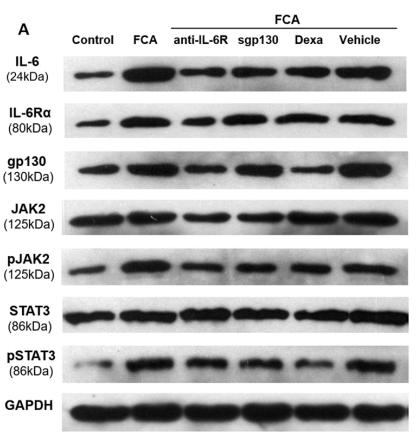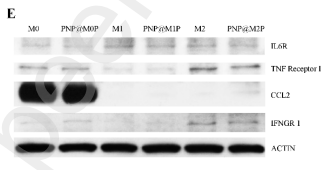IL6R Antibody - #DF6466
| Product: | IL6R Antibody |
| Catalog: | DF6466 |
| Description: | Rabbit polyclonal antibody to IL6R |
| Application: | WB IHC |
| Cited expt.: | WB, IHC |
| Reactivity: | Human, Mouse |
| Mol.Wt.: | 52kD; 52kD(Calculated). |
| Uniprot: | P08887 |
| RRID: | AB_2838428 |
Related Downloads
Protocols
Product Info
*The optimal dilutions should be determined by the end user. For optimal experimental results, antibody reuse is not recommended.
*Tips:
WB: For western blot detection of denatured protein samples. IHC: For immunohistochemical detection of paraffin sections (IHC-p) or frozen sections (IHC-f) of tissue samples. IF/ICC: For immunofluorescence detection of cell samples. ELISA(peptide): For ELISA detection of antigenic peptide.
Cite Format: Affinity Biosciences Cat# DF6466, RRID:AB_2838428.
Fold/Unfold
CD 126; CD126; CD126 antigen; gp80; IL 6R 1; IL 6R alpha; IL 6R; IL-6 receptor alpha chain; IL-6 receptor subunit alpha; IL-6R 1; IL-6R subunit alpha; IL-6R-alpha; IL-6RA; IL6Q; Il6r; IL6RA; IL6RA_HUMAN; IL6RQ; Interleukin 6 receptor; interleukin 6 receptor, alpha; Interleukin-6 receptor subunit alpha; Membrane glycoprotein 80; MGC30256;
Immunogens
A synthesized peptide derived from human IL6R, corresponding to a region within N-terminal amino acids.
Isoform 2 is expressed in peripheral blood mononuclear cells and weakly found in urine and serum.
- P08887 IL6RA_HUMAN:
- Protein BLAST With
- NCBI/
- ExPASy/
- Uniprot
MLAVGCALLAALLAAPGAALAPRRCPAQEVARGVLTSLPGDSVTLTCPGVEPEDNATVHWVLRKPAAGSHPSRWAGMGRRLLLRSVQLHDSGNYSCYRAGRPAGTVHLLVDVPPEEPQLSCFRKSPLSNVVCEWGPRSTPSLTTKAVLLVRKFQNSPAEDFQEPCQYSQESQKFSCQLAVPEGDSSFYIVSMCVASSVGSKFSKTQTFQGCGILQPDPPANITVTAVARNPRWLSVTWQDPHSWNSSFYRLRFELRYRAERSKTFTTWMVKDLQHHCVIHDAWSGLRHVVQLRAQEEFGQGEWSEWSPEAMGTPWTESRSPPAENEVSTPMQALTTNKDDDNILFRDSANATSLPVQDSSSVPLPTFLVAGGSLAFGTLLCIAIVLRFKKTWKLRALKEGKTSMHPPYSLGQLVPERPRPTPVLVPLISPPVSPSSLGSDNTSSHNRPDARDPRSPYDISNTDYFFPR
Research Backgrounds
Part of the receptor for interleukin 6. Binds to IL6 with low affinity, but does not transduce a signal. Signal activation necessitate an association with IL6ST. Activation may lead to the regulation of the immune response, acute-phase reactions and hematopoiesis.
Low concentration of a soluble form of IL6 receptor acts as an agonist of IL6 activity.
A short soluble form may also be released from the membrane by proteolysis.
Basolateral cell membrane>Single-pass type I membrane protein.
Secreted.
Isoform 2 is expressed in peripheral blood mononuclear cells and weakly found in urine and serum.
The two fibronectin type-III-like domains, contained in the N-terminal part, form together a cytokine-binding domain.
The WSXWS motif appears to be necessary for proper protein folding and thereby efficient intracellular transport and cell-surface receptor binding.
Belongs to the type I cytokine receptor family. Type 3 subfamily.
Research Fields
· Environmental Information Processing > Signaling molecules and interaction > Cytokine-cytokine receptor interaction. (View pathway)
· Environmental Information Processing > Signal transduction > HIF-1 signaling pathway. (View pathway)
· Environmental Information Processing > Signal transduction > PI3K-Akt signaling pathway. (View pathway)
· Environmental Information Processing > Signal transduction > Jak-STAT signaling pathway. (View pathway)
· Human Diseases > Drug resistance: Antineoplastic > EGFR tyrosine kinase inhibitor resistance.
· Human Diseases > Endocrine and metabolic diseases > Non-alcoholic fatty liver disease (NAFLD).
· Human Diseases > Cancers: Overview > Pathways in cancer. (View pathway)
· Organismal Systems > Immune system > Hematopoietic cell lineage. (View pathway)
· Organismal Systems > Immune system > Th17 cell differentiation. (View pathway)
References
Application: WB Species: Mouse Sample: LLC cells
Application: IHC Species: Human and Mouse Sample: A549 and LLC cells
Application: WB Species: rat Sample: spinal cord
Application: WB Species: Mouse Sample:
Restrictive clause
Affinity Biosciences tests all products strictly. Citations are provided as a resource for additional applications that have not been validated by Affinity Biosciences. Please choose the appropriate format for each application and consult Materials and Methods sections for additional details about the use of any product in these publications.
For Research Use Only.
Not for use in diagnostic or therapeutic procedures. Not for resale. Not for distribution without written consent. Affinity Biosciences will not be held responsible for patent infringement or other violations that may occur with the use of our products. Affinity Biosciences, Affinity Biosciences Logo and all other trademarks are the property of Affinity Biosciences LTD.





